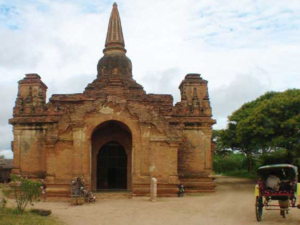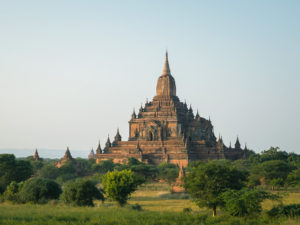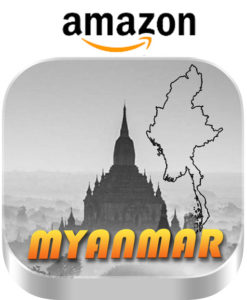The Art of Bagan
 Wall Paintings
Wall Paintings
Many temples of Bagan are illustrated with paintings on the interior and decorative stucco work on the exterior, as a work of merit. The murals were painted on a dry surface; they are not frescos where the paint is applied on wet cement. In a few temples, the Zatar or horoscope can be seen somewhere in a corner. Horoscopes are made on a person’s birth but here, they mark the ‘birth’ of the temple.
Through these pictures with captions in Pali, Old Mon or Bamar the ancient pilgrims could also study the faith. The themes are on the 550 Jataka Tales, the lives Buddha went through before he attained enlightenment as well as the biography of his life as Prince Siddhartha, his enlightenment as the Lord Buddha Gautama and his death.
It is one of the most effective ways of spreading Buddhism. Even today the tradition continues with a different type of presentation. Many pagodas in Bagan have walkways with series of panels or framed canvases hung close to the ceiling illustrating the Jataka Tales of the previous 550 lives of Buddha or scenes from his life, or the legend of how the particular pagoda came to be built and by whom.
Apart from scenes telling a story the walls or ceilings are often covered with lotus or figures in circular or square patterns. The lotus is a symbol of purity and often used in Buddhist art.
The importance of white elephants for the kings and in religious tales is seen in numerous murals; mythical creatures especially the Keinara bird people who symbolize fidelity were painted in different styles. One creature often seen in ancient temples but no longer in use is the Makkara while the use of the Naga or the crested dragon motif still exists to this day, as does the Keinara and the crested lion Chinthe. Another being often seen at pagodas is the Manote Thiha, a lion with double hind-quarters, sometimes with a crowned human head.
Also known as Maggan, the Makkara is a sea creature which has an elephant’s trunk, jaws of a crocodile, gills, scales, and tail of a fish, and claws of a lion, somewhat similar to the Rakhine Byarla. The walls were prepared for painting with an underlayer of red clay cement and sand; then a thin coat of lime was applied, after which was a final layer of fine cement. This would be rubbed until silky smooth with a piece of ivory.
The earliest painted temple is the Pahtothamya Temple of the 11th century. Early paintings were done mostly in four basic colors of black, white red and yellow and their combinations. Black was made from soot white was obtained from lime, and red and yellow ochre from river rocks encasing lumps of these brilliant colors. Adding the blue juice of the Indigo (Indigofera tinctona) leaves to yellow ochre gives green, color is rarely seen in the old wall paintings as it could easily become oxidized and turn brown. All colors were mixed with the sap of the Neem tree (Azadirachta indico) as the fixative, an age-old organic glue still used to this day and made by soaking the dried lumps of the clearest, purest sap in water. For a brighter hue, the paint was mixed with the gallbladder of animals.
Painting of the early Bagan period show people with strong Indian features; the Indian influence is seen also in the costume and pose. Since ancient times Brahmins have served at almost all SE Asian court; painters might have accompanied them to Bagan. Later the style changed so that the faces no longer have prominent features. On the whole, the stylized classical art has a similarity that runs through various periods, even if faces became gentler and bodies more willowy. The mythical creatures that abounded in these paintings such as ogres with evil faces or crested dragons almost exactly conform to accepted motifs
One temple, however, seemed to have had a painter who veered from tradition. In the early -13th century temple Gubyauk Gyi of Wetkyi In the village, two half-teardrop shaped panels on either edge of a wall displayed a popular subject, the attack of Mara’s armies on the Buddha who was on the point of enlightenment. The paintings show evil beings with bearded Indo-European faces and ordinary snakes instead of the classical dragons. Even the mythical creatures were of species unknown to traditional Myanmar art.
In one old monastery the Kyansittha Umin built in the early century, the wall paintings are believed painted after the fall of Bagan since one wall showed a Mongol soldier in breeches and wearing boots made of fur shooting an arrow. Another wall has a procession led by a dancer and musicians and followed by officials in long robes bearing gifts. These dignitaries wore ‘caps shaped like the rhinoceros horn’ mentioned by the Chinese scholar Chou Ch’u-fei in 1178 CE.
The faces of these celebrants are painted in such a way that one could not be sure if they were masked or if the artist was creating an entirely new style. If it is the latter, then the highly modernistic style marks an amazing point in art history.
In direct contrast to this creative approach are the paintings inside the Abeyadana Temple of the late 11th century. Executed with skill in the traditional manner, the paintings are of the usual Buddhist scenes but include many Mahayara motifs such as the Bodhisattvas and Tantric deities. This temple is unique in its numerous Mahayana symbols.
One painting that has fascinated scholars, writers and pilgrims is a small rectangular panel in the Nanda Manya Temple, showing a procession of women of all ages, including grandmothers with bent backs and withered breasts. In the middle, standing still as if reluctant to take a step, is the figure of a young girl. Her youth is emphasized by the smallness of her figure, A folk legend had grown up around it that the scene showed a bride escorted by female members of her family to be deflowered before the wedding by the Aree sect of priests. Some scholars deny the story, saying it must only be part of an ordinary ceremony.
A style of art that is freer than others can be seen on the walls of the Sulamuni Temple. They were presumably painted in the 14th century Pinya period or later, for the arched eyebrows and small mouths are typical of that era’s art.
All of the Bagan painting was on the walls; the only painting on the cloth was discovered rolled up inside an arm of a broken image during repairs. The fragment of cotton was restored in Rome and is now at the Bagan Archaeological Museum.
Datable to the 12th century, this piece of cloth measuring 31.7 inches wide and 53 inches high is exquisitely painted scenes from the Jataka ones. The lines are much more delicate than those seen on walls as presumably, the cotton would have a smoother surface used were cinnabar, regular, lacquer, carbon, yellow ochre, red ochre, and orpiment.
Temples built or renovated in the 18th and 19th centuries have paintings of those periods. Compared to the early Bagan paintings the figures are more fluid, the subject matter is often secular and ever irreverent, showing people at leisure, in a state of near-undress, or entwined with lovers, such as in the Ananda Oke Kyaung Monastery
Bagan art often showed faces with almond-shaped eyes surrounded by thick, short lashes, high cheekbones, oval faces, straight noses and gently curving but full lips. These features can still be seen on many inhabitants of villages such as Wetkyi In, Pwa Saw, or Min Nanthu, which have existed since the rule of King Anawrahta; the ancient artists might have painted the faces they saw in their communities.
 Stucco work
Stucco work
The exterior walls and arch pediments are often decorated with intricate stucco work. Unlike the few inventive styles in the paintings, here the Bagan masons stuck to traditional motifs in portraying mythical creatures, celestials, and ogres. Friezes are often repetitive series of a popular motif known as the Belu Pan Swei or ‘ogre clutching garlands’: the head of an ogre with garlands or strings of pearls in his jaws and fists. Cornel pilasters often portray stylized flowers called ‘Kanote’ and pediments over entrances soar in flame like motifs called Rama’s fingers in local architectural terms.
 Relief plaques
Relief plaques
The East and West Hpet Laik, Shwezigon and Mingalar Zedi Pagodas, and the Ananda Temple have high-relief plaques showing various Buddhist scenes. Usual subjects are events of the Buddha’s life or the scenes from the Jataka Tales. The two Hpet Laik Pagodas have terracotta plaques while the others are coated with a green glaze.
Some popular subjects are the attack of the evil Mara’s armies or the three daughters he sent to seduce the Buddha before Enlightenment. It is probable that the daughters symbolize the three biggest defilements of Buddhism: Lawba, greed; Dawsa, anger and Mawha, delusion.
On studying the glaze specialists found that it was made up of Silica, White Clay, Calcium, Lead Oxide, Tin Oxide, Copper Oxide, Chrome Oxide, Vanadium Oxide, and Feldspar. Old kilns for glazed ware were discovered in Bagan that have produced various colors: turquoise-blue, brownish-purple, olive-, emerald- and light green, although the glazes seen on the temples and pagodas were only various shades of green, yellow and cream.










